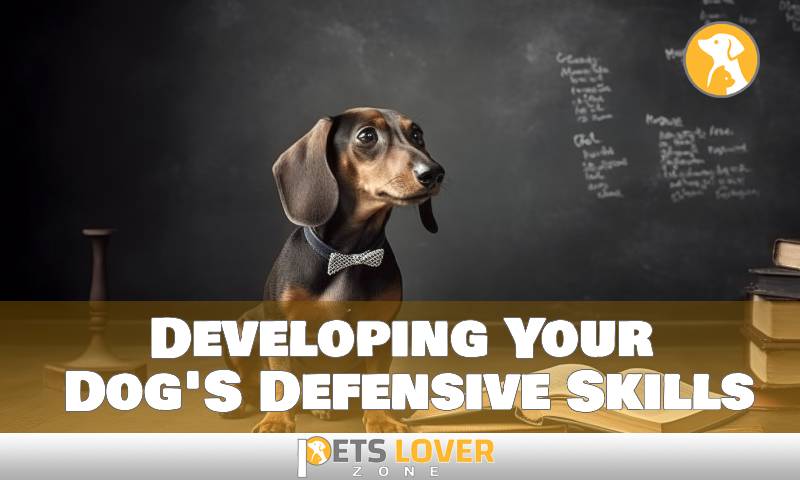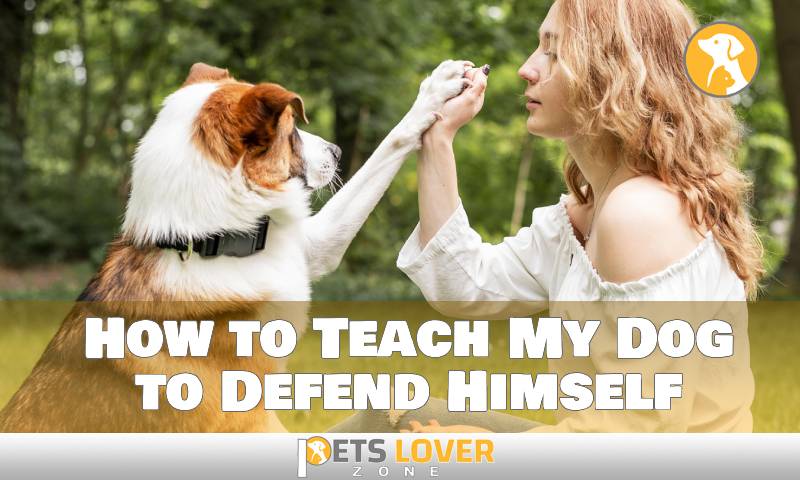Teaching your dog to defend himself requires professional training and guidance. To teach your dog to defend himself, professional training and assistance are necessary.
With the right techniques and instruction, your dog can learn to protect himself from potential threats and danger. It is important to remember that proper socialization and obedience training are crucial foundations before moving on to defense training. Additionally, it is imperative to only use positive reinforcement methods and avoid any negative or aggressive techniques.
Working with a qualified dog trainer can not only benefit your dog’s safety but also improve your relationship and bond with your pet. By investing in your dog’s training and well-being, you can help ensure their safety and happiness for years to come.
Protect Your Pup: Teach Your Dog To Defend Himself – The Basics
The Importance Of Early Training
Training your dog to defend himself from other animals is an essential skill that should be taught from a young age. This is particularly important for smaller dog breeds that are more vulnerable to predators. Here are some key points to consider when training your pup:
- Start training your dog from as early as six weeks of age to ensure they grasp the concept of biting and grow up to be effective protectors.
- Introduce your dog to different types of stimuli, including unfamiliar people, animals, and environments, so they get comfortable being in new situations.
- Make sure that your dog understands basic commands like “sit”, “stay”, “come” and “heel”. These commands will form the foundation of your dog’s advanced defensive training.
Understanding Your Dog’s Temperament And Natural Instincts
Every dog breed has unique characteristics and instincts. It’s crucial to take this into account when training your pup to defend himself. Here are some things you need to keep in mind when understanding your dog’s temperament and natural instincts:
- Identify your dog’s breed-specific characteristics and tailor your training methods to suit their unique traits.
- Observe how your dog reacts to different situations and stimuli to develop an understanding of their personality and natural behaviors.
- Understanding your dog’s pack mentality is essential to teaching them how to protect themselves. Dogs are instinctive pack animals and rely on their ‘pack leader’ for protection. Teaching your dog to defend themselves will instill in them the leadership traits needed to fend for themselves.
Training Methods: Positive Reinforcement Vs. Negative Reinforcement
Training your dog to protect themselves can be achieved through two primary methods, positive reinforcement, and negative reinforcement. Both methods have their advantages and disadvantages. Here are some things you need to consider when choosing a training method:
Positive reinforcement:
- Reward your dog with a treat or praise when they display the desired behavior.
- This method is said to be the most effective because it encourages your dog to repeat the desired behavior.
- Dogs respond better to positive reinforcement rather than punishment.
Negative reinforcement:
- Discourage undesirable behavior with a stern “no”, a gentle touch on the side, or withdrawal of a treat.
- This method can be stressful for your dog and can lead to aggressive behavior.
- Negative reinforcement should only be used in specific situations, and not as the primary training method.
Remember that training your dog to defend itself takes time and consistency. Start early, take your time, and consider your dog’s natural traits and behaviors in training. With dedication and patient practice, your dog will be better able to protect itself and become a well-rounded family pet.
Developing Your Dog’S Defensive Skills

Teaching your dog to defend himself is a responsible decision for any dog parent. Your canine companion should be able to protect himself and those he loves when necessary. It takes patience, effort, and consistency to develop your dog’s defensive skills, both physical and verbal.
Here are some ways to enhance your dog’s strength, agility, and communication skills.
Physical Exercises To Enhance Your Dog’S Strength And Agility:
- Start with warming-up exercises. Take your dog for a walk or jog before any intensive exercise.
- Train your dog for various physical activities, such as swimming, running, and jumping.
- Set up obstacle courses in your backyard or at a dog park to provide different challenges to your dog.
- Teach your dog to walk on a balance beam, crawl through tunnels, and jump over hurdles.
- Use toys like a tug rope, flying disc, or ball to make exercise more interactive.
Verbal Cues And Body Language For Improved Communication With Your Dog:
- Use simple commands for your dog to follow. Popular commands include sit, stay, come, and leave it.
- Use a firm but gentle tone and avoid yelling or hitting your dog.
- Practice hand signals to communicate with your dog in noisy surroundings.
- Show your dog that you are confident. Speak firmly and avoid being nervous or stressed.
- Use your body language to indicate to your dog what behavior to expect next.
Techniques For Teaching Your Dog To Protect Himself And You:
- Start by teaching your dog basic self-defense techniques such as barking loudly, ducking, and hiding behind objects.
- Teach your dog to bark and growl on cue to scare off strangers or unwanted visitors.
- Use a “place” command to direct your dog to a specific spot to protect it until you tell him it’s safe.
- Teach your dog proper behavior in an attack, such as biting and wrestling with a training toy.
- Hire a professional trainer to help you train your dog effectively.
Remember, your dog needs to know when to be aggressive and when to be calm. You are responsible for the safety of your dog, yourself, and others around you. Consistency, patience, and positive reinforcement are key elements to help your dog master these skills.
With proper training, your dog will be confident and capable of defending himself and those he loves.
Understanding Your Dog’S Defensive Responses
Dogs are pack animals and have a natural instinct to protect themselves, their territory, and their pack. Understanding your dog’s defensive responses is crucial when teaching him to defend himself. Here are some key points to consider:
- Dogs show different body language and vocal cues that indicate they feel threatened.
- The three types of aggression in dogs are fear-based aggression, territorial aggression, and possessive aggression.
The Body Language And Verbal Cues Dogs Show When They Sense Danger
Dogs use various body language and vocal cues to communicate their feelings. Knowing how to read your dog’s body language and vocal cues can help you understand when your dog senses danger. Here are some essential points to consider:
- Dogs might growl or bark in response to a perceived threat.
- A dog that feels threatened may become tense and still, with its ears erect, and its tail held high and stiff.
- A dog that is afraid may try to make itself look smaller and avoid eye contact.
- A dog that is feeling anxious or fearful might yawn, lick its lips, or cower.
How To Identify The Various Types Of Aggression In Dogs
Identifying the specific type of aggression in dogs is essential when teaching them to defend themselves. Here are some key points to consider:
- Territorial aggression is a type of aggression that dogs show when they feel their territory is threatened.
- Possessive aggression is when a dog displays aggression towards anyone who tries to take something they view as theirs.
- Fear-based aggression occurs when a dog is frightened, and perceives that a person or animal might hurt him.
Tips For Reading Canine Body Language
In addition to understanding the specific types of aggression in dogs, it is essential to know how to read your dog’s body language. Here are some essential tips to consider:
- Observe the position of your dog’s ears, tail, and body, as it can help you determine your dog’s current emotional state.
- Look at your dog’s eyes. Wide, open, and relaxed eyes could indicate that your dog is comfortable, while darting eyes or dilated pupils could suggest anxiety.
- Pay attention to your dog’s vocalizations, such as barking, growling, and whining, to learn more about their emotional state.
By understanding your dog’s defensive responses, identifying the various types of aggression in dogs, and reading your dog’s body language, you can teach your dog to defend themselves effectively.
Putting It All Together

Teaching your dog to defend himself is an essential aspect of dog ownership. Doing so can provide them with the necessary skills to protect themselves, communicate with other dogs, and prevent potential danger. If you’re looking for ways to integrate self-defense training into your dog’s regular routine, create realistic scenarios to simulate real-life dangers, and understand the practical applications of self-defense training in daily life, then read on.
Integrating Self-Defense Training Into Your Dog’S Regular Routine
Integrating self-defense training into your dog’s regular routine requires patience, commitment, and consistency. The following tips can help:
- Start with basic commands such as ‘come’, ‘sit’, ‘stay’, and ‘heel’
- Move onto advanced commands such as ‘watch’, ‘leave it’, and ‘place’
- Teach bite inhibition and use positive reinforcement to reward good behavior
- Incorporate fun activities like tug of war and fetch into training sessions
Creating Realistic Scenarios To Simulate Real-Life Dangers
Creating realistic scenarios to simulate real-life dangers is crucial in preparing your dog for potential danger. Dog-to-dog interaction should be the main focus, and the following tips can be useful:
- Identify the most common dangers in your area (e.g. Off-leash aggressive dogs, coyotes)
- Create a mock situation with a trusted dog to serve as a practice partner
- Reward positive behavior and teach your dog to read other dogs’ body language
- Gradually increase the level of difficulty to allow for growth and improvement
Practical Applications Of Self-Defense Training In Daily Life
Understanding the practical applications of self-defense training in daily life is crucial in ensuring your dog’s safety and protection. Here are some practical tips:
- Use self-defense training as a way to prevent potential dangers, not just to react to them
- Teach your dog to recognize and respond to threatening behavior
- Always keep your dog on a leash in potentially high-risk areas
- Be aware of your surroundings and anticipate potential dangers
Teaching your dog how to defend himself is an essential aspect of being a responsible dog owner. By integrating self-defense training into your dog’s regular routine, creating realistic scenarios to simulate real-life dangers, and understanding the practical applications of the training in daily life, you can provide your dog with the necessary skills to communicate, protect themselves, and prevent potential danger.
FAQs
Is It Safe To Teach My Dog To Defend Himself?
Yes, it is safe to teach your dog to defend himself, especially if he is frequently exposed to other dogs or animals that may harm him. However, it should be done under the supervision of a professional dog trainer to avoid any harm to your dog or others.
How Can I Teach My Dog To Defend Himself?
The best way to teach your dog to defend himself is by enrolling him in a self-defense training class with a professional dog trainer. The trainer will teach your dog how to defend himself when under threat with various techniques like blocking and biting.
Is It Legal For My Dog To Defend Himself?
Yes, it is legal for your dog to defend himself if he is under threat or being attacked by another dog or animal. However, it is important to remember that excessive force or aggression by your dog could result in legal consequences.
Can Any Dog Learn To Defend Himself?
Yes, any dog can learn to defend himself with proper training and under the guidance of a professional trainer. However, certain breeds may be more inclined to self-defense, such as guard dogs and working dogs.
How Long Will It Take To Teach My Dog To Defend Himself?
The time it takes to teach your dog self-defense depends on his breed, personality, and the training method used. Generally, it could take 6-8 months for your dog to learn self-defense techniques, but consistent practice and reinforcement can accelerate the process.
Can Teaching My Dog Self-Defense Make Him Aggressive?
No, teaching your dog self-defense does not make him aggressive. Instead, it helps him control his instinct and respond confidently to adverse situations, making him more assertive and confident. However, it is important to ensure that your dog is well-socialized and trained to behave appropriately in other situations.
Conclusion
To wrap up, teaching your dog to defend themselves is a great investment in their well-being. Remember, not every scenario is about aggression or confrontation; rather, creating an instinct for protection is important. Practice will make it more precise and increase their confidence.
Start with the basics like commands such as sit, stay, and come, then progress to protection-specific training. Be patient with your dog and make it fun with positive reinforcement. Always ensure that safety is the priority, both for yourself and your dog.
With time, patience, and plenty of practice, your dog will be able to step up their game and defend themselves if the need arises. So, why wait? Begin teaching your dog to defend themselves now!





